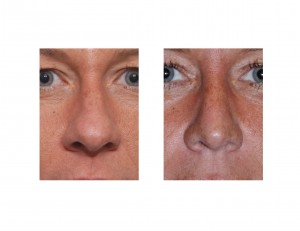Background: Aesthetic nasal concerns present in a wide variety of deformities throughout the length of the nose. One of the more common basic nasal concerns is the wide or broad nasal tip. Some patients call it a fat tip or a bulbous tip. While all of these names seem synonymous there are actually a wide variety of tip deformities that fall under the category of the so-called broad nasal tip.
The shape of the nasal tip is strong influenced by the size and position of the paired lower alar cartilages. These scrolled cartilages present in highly different patterns amongst each patient that makes them almost as unique as one’s fingerprints. Their top to bottom length and how they meet in the middle to create the shape of the dome is what gives the shape to the tip. Thin lower alar cartilages that meet very close in the middle over the end of the septum make for a thin and well-defined nasal tip. Conversely, large lower alar cartilages that do not come closer together make for variously shaped broad nasal tip shapes.
Tip modifications are the most common denominator amongst all rhinoplasty procedures. While an occasional hump reduction (upper nose) is done in isolation, it is much more common to do an isolated tip reshaping. (lower nose) There are probably few primary rhinoplasties ever done that don’t do at least some minor adjustment to the lower alar cartilages.
Case Study: This 44 year-old female wanted to change her broad nasal tip. She felt it was too big for her face and unatractive. She had always wanted it changed and now had the resources to have it done. She had no concerns about her upper nose and was fairly happy with the nasal bridge. She did have a minor hump at the osteocartilaginous junction and modestly thick nasal skin.



Case Highlights:
1) The wide or big nasal tip is a common motivation to undergo rhinoplasty.
2) A rhinoplasty result in which thinning the nasal tip and giving it more definition is highly influenced by the thickness of the overlying skin. The thicker the skin the longer it takes to see the final result.
3) When the nasal tip is modified, usually changes above the tip along the dorsal line are needed as well for nasal balance.
Dr. Barry Eppley
Indianapolis, Indiana


